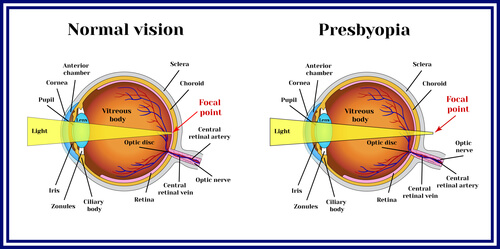What is Presbyopia?
Presbyopia is a common age-related condition in which the eye loses its ability to focus on objects up close. It usually starts to occur in your mid-40s and affects nearly everyone by age 60. With presbyopia, you may have trouble reading small print, working on a computer, or doing other close-up tasks.
Presbyopia occurs because the natural lens of the eye, which helps us focus, becomes less flexible with age. This makes it more difficult for the eye to change its focus from distant to near objects. The condition is not caused by any disease or injury and does not typically worsen over time. However, it can cause frustration and eyestrain when doing close-up work.

Who is Typically Affected by Presbyopia?
Presbyopia is a normal part of the aging process that affects nearly everyone over 40. It is a progressive condition that typically occurs in your mid-40s and affects nearly everyone by age 60. Whether you are nearsighted, farsighted, or have had laser vision correction, presbyopia can still occur as you age.
As a result, it can affect people of all ages, genders, and ethnicities, regardless of their overall health or eye health status. Suppose you are over the age of 40 and are experiencing difficulty seeing objects up close. In that case, it is vital to have a comprehensive eye exam to determine if presbyopia is the cause and to discuss the best vision correction options for your individual needs.
What Are the Symptoms of Presbyopia?
The signs and symptoms of presbyopia typically include:
- Difficulty reading small print or doing close-up tasks, such as reading, sewing, or working on a computer
- Eyestrain or headache when doing close-up work
- Holding reading materials or other objects at arm’s length to see them more clearly
- Blurring of close-up vision that improves when you step back or hold the object further away
- The need to change your reading glasses or glasses prescription more often
If you are experiencing these symptoms, it is crucial to have a comprehensive eye exam to determine if presbyopia is the cause. During the exam, your eye doctor will check your near and far vision and your eye health to determine the best treatment options for your individual needs. Presbyopia treatment options may include prescription reading glasses, progressive lenses, bifocal or trifocal glasses, or contact lenses. Surgery, such as LASIK or multifocal implantable contact lenses, may also be recommended in some cases.
How is Presbyopia Diagnosed?
Presbyopia is typically diagnosed during a comprehensive eye exam. Your eye doctor will evaluate your near and far vision and your eye health to determine the cause of any changes in your vision.
During the exam, your eye doctor may perform several tests, including:
- Visual Acuity Test: This measures how well you can see letters or numbers at a distance.
- Refraction Test: This measures the correction you need for near and far vision.
- Near Vision Test: This measures your ability to see objects up close.
- Cover Test: This measures the coordination of your eyes and checks for misalignment.
- Slit Lamp Exam: This allows your eye doctor to examine the front and lens of your eye.
Based on the results of these tests, your eye doctor can diagnose presbyopia and determine the best treatment options for your individual needs. If necessary, your eye doctor may also refer you to a specialist for further evaluation and treatment.
What Treatments are Available for Presbyopia?
The following are some of the treatment options available for presbyopia:
- Reading Glasses: Non-prescription reading glasses can be purchased over the counter at various retailers. Prescription reading glasses can be tailored to your specific needs and can be made in various styles and strengths.
- Progressive Lenses: Progressive lenses have multiple focusing zones, allowing you to see clearly at all distances – near, intermediate, and far.
- Bifocal or Trifocal Glasses: Bifocal and trifocal glasses have two or three lenses with different prescriptions in one frame. This allows you to see clearly at different distances.
- Contact Lenses: Multifocal contact lenses can be prescribed to correct both near and far vision, providing a convenient and comfortable alternative to glasses.
- Surgery: In some cases, surgery, such as LASIK or multifocal implantable contact lenses, may also be recommended.
It’s essential to have a comprehensive eye exam to determine the best treatment option for your individual needs. Your eye doctor will consider your lifestyle, occupation, and other factors when recommending the best treatment for you.
Sometimes, a combination of treatments may be recommended for optimal vision correction.
How do You Treat Presbyopia Naturally?
While there is no cure for presbyopia, there are some lifestyle changes and natural remedies that may help alleviate its symptoms:
- Exercises for the eyes: Regularly performing eye exercises can help improve your ability to focus on near objects and reduce eye strain.
- Good lighting: Make sure the lighting in your home and work environment is bright enough to reduce eye strain and improve your ability to see up close.
- Proper nutrition: Eating a diet rich in antioxidants and vitamins, such as vitamins A and C, can help support eye health and reduce the risk of eye problems.
- Regular breaks: Taking breaks when reading or working on a computer can help reduce eye strain and improve focus.
- Hydration: Staying hydrated can help keep your eyes moist and reduce the risk of dry eyes, which can cause discomfort and affect your ability to focus on near objects.
- Regular eye exams: Regular comprehensive eye exams can help detect changes in your vision and allow you to receive timely treatment if needed.
It’s important to remember that these remedies are not a cure for presbyopia and may not work for everyone. If you are experiencing presbyopia symptoms, you must see an eye doctor for a comprehensive eye exam and proper diagnosis and treatment.
What is the Difference Between Presbyopia and Hypermetropia?
Presbyopia and hypermetropia are two different eye conditions:
Presbyopia is an age-related condition where the natural lens in the eye loses its elasticity and ability to change shape to focus on close objects. This results in difficulty reading or performing close-up tasks.
Hypermetropia, also known as farsightedness, is a refractive error in which distant objects are seen more clearly than nearby objects. This is because the eye is too short or the cornea is too flat, causing light to focus behind the retina.






